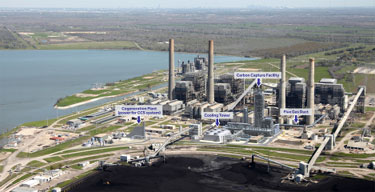NRG Energy has come up with an interesting use for carbon emissions from coal plants – use it for oil drilling – one fossil fuel begets another.
In the first time carbon capture and sequestration will be deployed commercially, the utility is investing $1 billion in retrofitting a coal plant that will supply the oil industry with carbon-injected oil fields, which is in high demand for enhanced oil recovery.
The idea is to capture carbon emissions from a coal plant, thus selling clean electricity, and also sell sequestered carbon to the oil industry so they can extract oil from depleted fields.
Work has started on a coal plant near Houston. Equipment is being installed that captures the exhaust (flue gas) and separates out the carbon, which is then piped 82 miles away to a depleted oil field. Once it gets there it will be pumped underground, facilitating "enhanced" oil recovery.
Parish complex:

Once carbon is in beneath the soil, it loosens the remaining crude oil, bringing new life to old wells. NRG, which has a financial interest in the well, says it could increase production from 500 barrels per day now to over 15,000 barrels. And it will prevent about 1.6 million tons of carbon dioxide from entering the atmosphere.
That’s a small fraction of the coal plant’s emissions, however, given that the Parish complex is the biggest fossil fuel power plant in the US, with four coal and six gas units. The retrofit applies to 40% of one coal unit.
But this is just the first project.
NRG says the carbon capture system removes virtually all sulfur dioxide. The unit already has particulate matter and nitrogen oxide controls and mercury controls will be installed by 2015. The flue gas is expected to be among the cleanest fossil fuel emissions in the world.
For now, "carbon flooding" is considered a big market with 160 billion barrels of oil in otherwise depleted wells. It could all be tapped by injecting carbon, worth $17 trillion according to Frost & Sullivan, at current prices.
While most utilities are currently at war with renewable energy, NRG leads on solar and wind, and recently spun off NRG Yield.
Other carbon capture projects:
- the first large scale carbon sequestration project in the US operates with an ethanol plant in Illinois.
- the Texas Clean Energy Project, scheduled to come online in 2015, will also capture carbon for enhanced oil recovery
- One company wants to capture carbon from industrial processes and use it to create geothermal energy.
- Shell wants to cut carbon emissions from tar sands by capturing it and injecting it underground.
-
Norway opened a $1 billion capture and storage plant in 2012 – the largest in the world.
What do you think? Should coal be phased out altogether or are "clean" coal plants a good idea?

IF in fact carbon capture is 100% effective (or 99.999%), then coal gets a new life which helps those who have made a living in mining and transporting the same, and that’s a social good.
Then the oil industry end of things needs to demonstrate that the carbon is not merely replaced by what they marginally emit.